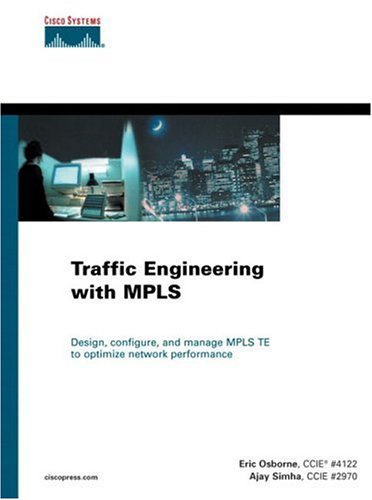

Most ebook files are in PDF format, so you can easily read them using various software such as Foxit Reader or directly on the Google Chrome browser.
Some ebook files are released by publishers in other formats such as .awz, .mobi, .epub, .fb2, etc. You may need to install specific software to read these formats on mobile/PC, such as Calibre.
Please read the tutorial at this link. https://ebooknice.com/page/post?id=faq
We offer FREE conversion to the popular formats you request; however, this may take some time. Therefore, right after payment, please email us, and we will try to provide the service as quickly as possible.
For some exceptional file formats or broken links (if any), please refrain from opening any disputes. Instead, email us first, and we will try to assist within a maximum of 6 hours.
EbookNice Team

Status:
Available0.0
0 reviewsDesign, configure, and manage MPLS TE to optimize network performance
Almost every busy network backbone has some congested links while others remain underutilized. That's because shortest-path routing protocols send traffic down the path that is shortest without considering other network parameters, such as utilization and traffic demands. Using Traffic Engineering (TE), network operators can redistribute packet flows to attain more uniform distribution across all links. Forcing traffic onto specific pathways allows you to get the most out of your existing network capacity while making it easier to deliver consistent service levels to customers at the same time.
Cisco(r) Multiprotocol Label Switching (MPLS) lends efficiency to very large networks, and is the most effective way to implement TE. MPLS TE routes traffic flows across the network by aligning resources required by a given flow with actual backbone capacity and topology. This constraint-based routing approach feeds the network route traffic down one or more pathways, preventing unexpected congestion and enabling recovery from link or node failures.
Traffic Engineering with MPLS provides you with information on how to use MPLS TE and associated features to maximize network bandwidth. This book focuses on real-world applications, from design scenarios to feature configurations to tools that can be used in managing and troubleshooting MPLS TE. Assuming some familiarity with basic label operations, this guide focuses mainly on the operational aspects of MPLS TE-how the various pieces work and how to configure and troubleshoot them. Additionally, this book addresses design and scalability issues along with extensive deployment tips to help you roll out MPLS TE on your own network.
"Eric and Ajay work in the development group at Cisco that built Traffic Engineering. They are among those with the greatest hands-on experience with this application. This book is the product of their experience." -George Swallow, Cisco Systems, Architect for Traffic Engineering Co-Chair, IETF MPLS Working Group
Eric Osborne , CCIE(r) #4122, has been doing Internet engineering of one sort or another since 1995. He joined Cisco in 1998 to work in the Cisco Technical Assistance Center (TAC), moved from there to the ISP Expert team and then to the MPLS Deployment team. He has been involved in MPLS since the Cisco IOS(r) Software Release 11.1CT days.
Ajay Simha , CCIE #2970, joined the Cisco TAC in 1996. He then went on to support tier 1 and 2 ISPs as part of Cisco's ISP Expert team. Ajay has been working as an MPLS deployment engineer since October 1999, and he has first-hand experience in troubleshooting, designing, and deploying MPLS.